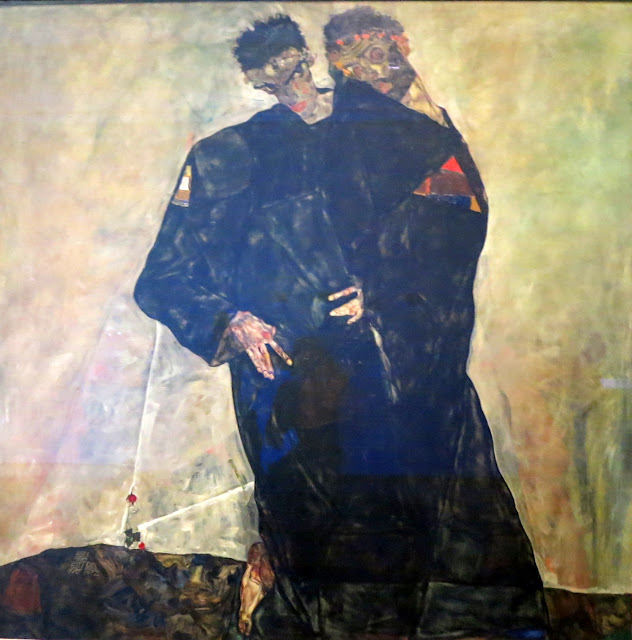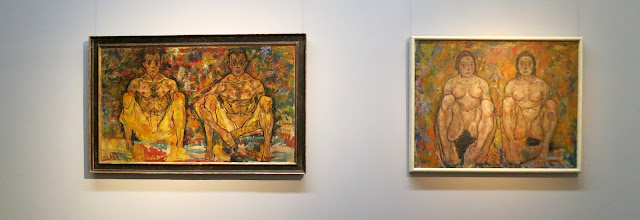Egon Schiele
at the Leopold Museum in Vienna.
I was looking forward to seeing the work of Gustav Klimt when we travelled to Vienna, but it was the haunting paintings and drawings of Egon Schiele that touched me to the core and seeing the vast collection at the Leopold, but in other galleries too, made me realise how little I knew of his work.
The two artists met when Klimt was 45 years old and the celebrated master of Viennese Jugenstil. 'Am I talented?' the then 17-year old Schiele asked Klimt when he had the opportunity to show him some of his drawings in his studio. 'Talented? Yes, much too much', was Klimt's reply. The art journalist Arthur Roessler even claimed that Klimt made the following statement: 'I envy you the expression in the faces you paint'.
The Leopold holds the largest compilation of works by the artist, comprising more than 40 oil paintings and around 190 works on paper from all periods of the artist's oeuvre.
Despite his early death at only 28 years of age, Schiele created an oeuvre with distinctive stylistic periods and ideological designs. When he was only 20 years old, he created a radical Expressionism with extreme bodily gestures, followed soon after by images of symbolist and mystical content.
After a traumatic spell in prison his compositions appeared calmer and richer in context. WWI made it difficult for him to work. During the last years of his life he became more realistic and his gaze turned outwards. Just as he was about to embark on a new period inspired by the movement of New Objectivity, the artist died within days of his - then pregnant - wife, in the autumn of 1918.
Schiele invested his art with an emotional intensity that, coupled with his radical formal innovations,
characterised the Austrian contribution to Expressionism. The very aspects of his art that precluded its popularity during much of his lifetime - ugly distortion in place of accepted notions of beauty, unveiled eroticism, and personal angst - are those for which he is considered most compelling today.
Stylised Flowers in Front of Decorative Background, 1908 (oil, silver and gold bronze on canvas)
Nude Study, 1908 (oil on cardboard)
His numerous self-portraits portray an uninhibited exhibitionism, but in reality Schiele was said to be shy and sensitive.
Self-Portrait with Striped Shirt, 1910
Nude Self-Portrait with Open Mouth, 1910
The self-portraits are psychologically complex images. The emaciated, tortured figure of the artist, bony and angular, is full of an inner tension. Schiele stares wildly, his large, dark eyes glaring menacingly, his mouth open, and his hair standing on end.
Preacher (Nude Self-Portrait with Blue-Green Shirt), 1913, (pencil, gouache on paper)
Nude Self-Portrait , Squatting, 1918, (black chalk on paper)
Self-Portrait as Kneeling Nude, 1910, (black chalk, gouache on paper)
Extreme angles, brutal croppings, twisted fingers and limbs, and yet, the human form is exhibited as a piece of flesh.
Seated Male Nude, (self-Portrait), 1910, (oil, opaque colour on canvas)
Schiele owned a German translation of Rimbaud's poems and knew some of them by heart. The ecstatic atmosphere in 'The Drunken Boat' described below matches the self-portraits from this period perfectly:
The green water penetrated by pinewood hull
And washed me clean of the bluish wine-stains and the splashes of vomit,
Carrying away both rudder and anchor.
And from that time on I bathed in the Poem
Of the Sea, star-infused and churned into milk,
Devouring the green azures, where entranced in pallid flotsam
A dreaming drowned man sometimes goes down.
(from the poem The Drunken Boat, by Arthur Rimbaud).
Small Tree in Late Autumn, 1911, (oil on wood)
Moa, 1911, (pencil, watercolour, opaque colour on paper)
Semi Nude, (Self-Portrait), 1911, (pencil, gouache on paper)
The Lyricist, 1911, (oil on canvas)
Self-Seer I (Death and Man), 1911, (oil on canvas)
Landscape with Ravens, 1911, (oil on canvas)
Lord, when the open field is cold,
When in the battered villages
The endless angelus dies
Above the dark and drooping world
Lets the empty skies disclose
Your dear, delightful crows.
Armada dark with harsh cries,
Your nests are tossed by icy winds!
Along the banks of yellowed ponds,
On road where crumbling crosses rise,
In cold and gray and mournful weather
Scatter, hover, dive together!
The Hermits, 1912, (oil on canvas)
This double portrait is commonly thought to symbolise Schiele's breaking away from Klimt. Both artists are shown wearing long black caftans, with the older man, blinded and leaning against and partially concealed behind the younger. In keeping with other self-images as a martyr, Schiele imagines himself and his mentor as existing on the fringes of society, only now he has become the dominant successor, gazing boldly outward.
Nude Self-Portrait, (Study for the 'Sema' portfolio), 1912, (india ink on paper)
Self-Portrait with Chinese Lantern Plant, 1912, (oil, opaque colour on wood)
Portrait of Wally Neuzil, 1912, (oil on wood)
Mourning Woman, 1912, (oil on wood)
Caress (Cardinal and Nun), 1912, (oil on canvas)
Mother and Child, 1912, (oil on wood)
Blind Mother, 1914, (oil on canvas)
Rear View of a Female Half-Nude with Cloth, (fragment), 1913, (oil on canvas)
House Wall on the River, 1915, (oil on canvas)
House with Shingle Roof (Old House II), 1915, (oil on canvas)
A large number of the depictions of houses and cityscapes show one and the same city - Krumau in Southern Bohemia. Schiele was especially taken with the tight, winding streets and the old morbid-looking facades and roofs. Through slight manipulations, he changed the city's actual topography and invested the empty streets with a magical, dreamy atmosphere. He minutely rendered the details of individual motifs, an example being the lovingly depicted roof shingles in the painting above. The washing line with laundry in front of the house is a clear reference to its inhabitants.
Krumau on the Vitava (The Small Town III), 1914, (oil, black chalk on canvas)
Mother with Two Children, 1915, (oil on canvas)
Mother and Child, 1914, (pencil, gouache on paper)
Edith Schiele with Striped Dress, Sitting, 1915, (pencil, gouache on paper)
Three Standing Women (fragment), 1918, (unfinished), (oil on canvas)
Two Squatting Men (double self-portrait), (oil on canvas)
Two Squatting Women, (unfinished), 1918, (oil on canvas)
Reclining Woman, 1917, (oil on canvas)




































I'm glad that you got to see all the Schiele works. His work speaks so clearly of the appalling poverty and turmoil of those years, and yet I so love the almost fairytale aspects of his architectural and landscape pieces. Thank you for this collection - it is appropriate for these days.
ReplyDeleteSeeing so much of his work was a real pleasure. Ken and I don't always agree on what we like, but there was total agreement in this case.
Delete